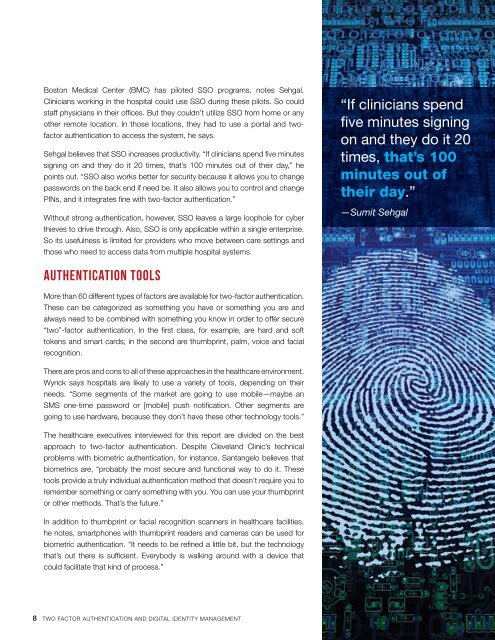Two factor authentication and digital identity management
2izGJqj
2izGJqj
Create successful ePaper yourself
Turn your PDF publications into a flip-book with our unique Google optimized e-Paper software.
Boston Medical Center (BMC) has piloted SSO programs, notes Sehgal.<br />
Clinicians working in the hospital could use SSO during these pilots. So could<br />
staff physicians in their offices. But they couldn’t utilize SSO from home or any<br />
other remote location. In those locations, they had to use a portal <strong>and</strong> two<strong>factor</strong><br />
<strong>authentication</strong> to access the system, he says.<br />
Sehgal believes that SSO increases productivity. “If clinicians spend five minutes<br />
signing on <strong>and</strong> they do it 20 times, that’s 100 minutes out of their day,” he<br />
points out. “SSO also works better for security because it allows you to change<br />
passwords on the back end if need be. It also allows you to control <strong>and</strong> change<br />
PINs, <strong>and</strong> it integrates fine with two-<strong>factor</strong> <strong>authentication</strong>.”<br />
Without strong <strong>authentication</strong>, however, SSO leaves a large loophole for cyber<br />
thieves to drive through. Also, SSO is only applicable within a single enterprise.<br />
So its usefulness is limited for providers who move between care settings <strong>and</strong><br />
those who need to access data from multiple hospital systems.<br />
“If clinicians spend<br />
five minutes signing<br />
on <strong>and</strong> they do it 20<br />
times, that’s 100<br />
minutes out of<br />
their day.”<br />
—Sumit Sehgal<br />
Authentication tools<br />
More than 60 different types of <strong>factor</strong>s are available for two-<strong>factor</strong> <strong>authentication</strong>.<br />
These can be categorized as something you have or something you are <strong>and</strong><br />
always need to be combined with something you know in order to offer secure<br />
“two”-<strong>factor</strong> <strong>authentication</strong>. In the first class, for example, are hard <strong>and</strong> soft<br />
tokens <strong>and</strong> smart cards; in the second are thumbprint, palm, voice <strong>and</strong> facial<br />
recognition.<br />
There are pros <strong>and</strong> cons to all of these approaches in the healthcare environment.<br />
Wyrick says hospitals are likely to use a variety of tools, depending on their<br />
needs. “Some segments of the market are going to use mobile—maybe an<br />
SMS one-time password or [mobile] push notification. Other segments are<br />
going to use hardware, because they don’t have these other technology tools.”<br />
The healthcare executives interviewed for this report are divided on the best<br />
approach to two-<strong>factor</strong> <strong>authentication</strong>. Despite Clevel<strong>and</strong> Clinic’s technical<br />
problems with biometric <strong>authentication</strong>, for instance, Santangelo believes that<br />
biometrics are, “probably the most secure <strong>and</strong> functional way to do it. These<br />
tools provide a truly individual <strong>authentication</strong> method that doesn’t require you to<br />
remember something or carry something with you. You can use your thumbprint<br />
or other methods. That’s the future.”<br />
In addition to thumbprint or facial recognition scanners in healthcare facilities,<br />
he notes, smartphones with thumbprint readers <strong>and</strong> cameras can be used for<br />
biometric <strong>authentication</strong>. “It needs to be refined a little bit, but the technology<br />
that’s out there is sufficient. Everybody is walking around with a device that<br />
could facilitate that kind of process.”<br />
8 TWO FACTOR AUTHENTICATION AND DIGITAL IDENTITY MANAGEMENT


